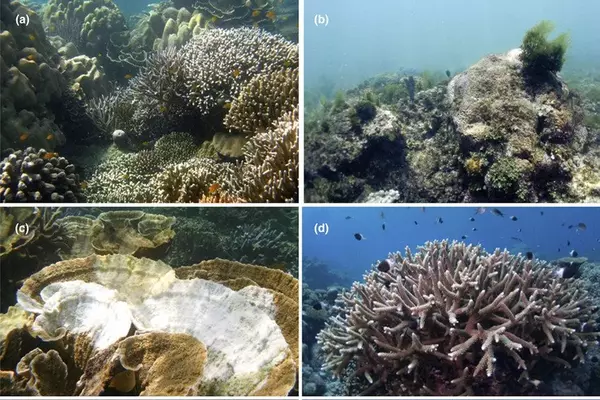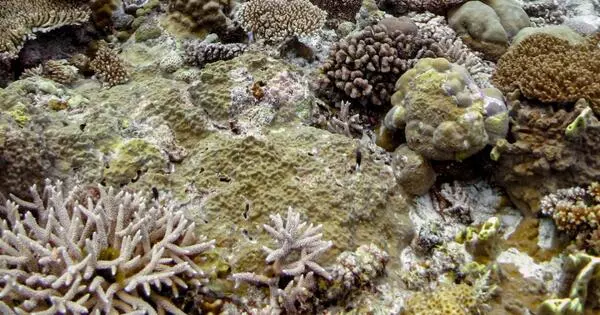Corals in the Atlantic Ocean have declined precipitously in recent years as a result of global warming and other environmental changes, whereas corals in the Pacific and Indian Oceans have fared better. An international team led by Penn State discovered that these mutualistic relationships from the Indo-Pacific may be more flexible and ultimately resilient to higher ocean temperatures than those in the Atlantic by describing several species of symbiotic algae that these corals require to grow.
Coral reefs are vast geological structures composed of calcium carbonate produced by coral animals, the colonies of which contain dense populations of photosynthetic algae from the family Symbiodiniaceae – referred to herein as “symbionts” – within their tissues. Coral bleaching occurs when environmental factors, such as rising ocean temperatures, disrupt the relationship between algae and coral animals, resulting in a white, or bleached, colony. While corals can recover, depending on the severity and duration of the stress, bleaching may result in coral mortality.
“Coral bleaching not only affects the corals themselves, but also entire ecosystems of organisms – from invertebrates, like sea urchins and spiny lobsters, to vertebrates, like fish and sea turtles,” said Todd LaJeunesse, professor of biology, Penn State. “It’s important to study the biology of corals and their symbionts so we can predict how they will respond to future environmental changes, especially ocean warming.”
Coral bleaching not only affects the corals themselves, but also entire ecosystems of organisms – from invertebrates, like sea urchins and spiny lobsters, to vertebrates, like fish and sea turtles.
Todd LaJeunesse
However, not all corals and symbionts will react the same way, according to LaJeunesse. This is due to the fact that the world’s oceans contain thousands of different coral species, each with its own set of characteristics. And, he claims, until recently, no one appreciated the vast diversity of symbiont species and their importance to coral survival.
“Previously, scientists grouped all symbionts into a few broad groups,” LaJeunesse explained. “Over the past several years, my lab’s work has been to describe individual species of symbiont so we know what we’re dealing with. Without this information, it is impossible to study the ecology, physiology, and biogeography of corals.”
As LaJeunesse and his colleagues began to describe symbiont species, they discovered that some are specialists, meaning they can only associate with one or a few species of coral hosts, whereas others are generalists, meaning they can associate with many. Furthermore, they discovered that some corals, particularly in the Caribbean, rely on specialist symbionts, whereas corals in the Indo-Pacific associate with generalists. Caribbean corals may be more sensitive to environmental changes due to a lack of flexibility, whereas Indo-Pacific corals with more flexible partnerships may be able to withstand greater environmental change.

Indeed, according to LaJeunesse, the symbiont species that the team described are important to reef ecosystems because of their ecological dominance and their importance to so many coral species over huge geographic areas.
He said, “It’s possible that these species may come to dominate coral communities as Earth’s oceans warm and more sensitive symbionts die out.”
The team’s new study, published in the Journal of Phycology on May 1, provides formal descriptions for several host-generalist symbiont species in the Indo-Pacific region. The researchers collected coral samples from reefs across the Indo-Pacific, including Palau, Thailand, Tanzania’s Zanzibar, the Phoenix Islands, Australia’s Great Barrier Reef, and New Caledonia. They then extracted and sequenced the DNA of the symbiotic algae from these samples. They then identified and described five symbiont species that can associate with various host coral species.
“It’s difficult to communicate about things we don’t understand or even have a name for,” said Caleb Butler, a graduate student in biology at Penn State and the paper’s first author. “When we formally describe a species, we give these organisms a name, which helps to build an identity that we can talk about and allows us to connect previous studies with future research.” The organisms described here are widespread, and as ocean temperatures rise, these thermally tolerant generalists are likely to spread to new coral communities. Recognizing these distinct species allows for informed research into their ecology, as well as the ability to communicate accurately about the implications of our findings.”
Specifically, the symbionts that the team described are in the genus Cladocopium.
“Cladocopium are exceptionally biodiverse relative to other coral symbionts; yet very few species from this genus have been successfully cultured,” said Matthew Nitschke, research scientist at the Australian Institute of Marine Science (AIMS). “C. proliferum, one of the species described by the team, can be cultured in a test tube, allowing significant progress toward understanding the mechanisms underlying coral-algal symbiosis, and it has become a model species for such research in Australia.” Professor Madeleine van Oppen’s Australian team is currently using C. proliferum cultures in reef restoration research and development, with a focus on how these algal symbionts contribute to coral heat tolerance.”





